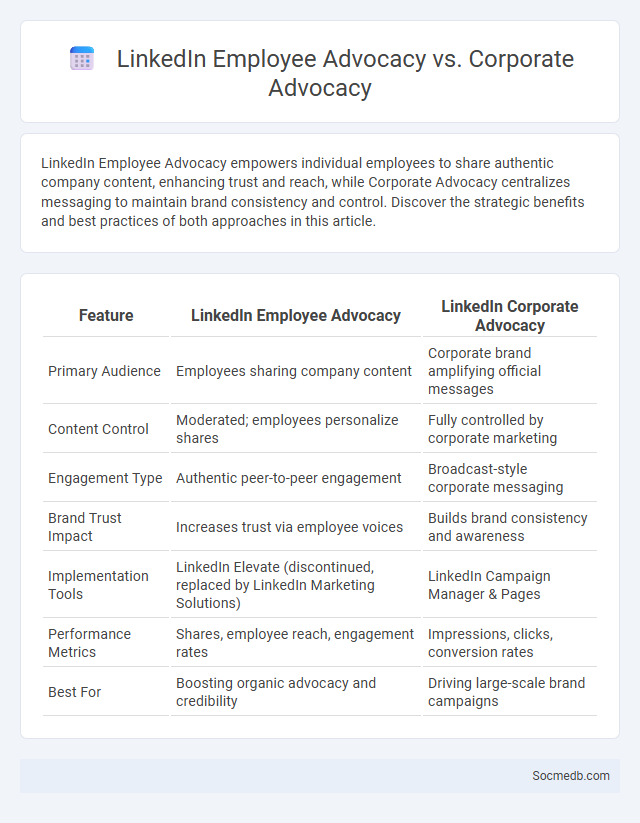
Photo illustration: LinkedIn Employee Advocacy vs Corporate Advocacy
LinkedIn Employee Advocacy empowers individual employees to share authentic company content, enhancing trust and reach, while Corporate Advocacy centralizes messaging to maintain brand consistency and control. Discover the strategic benefits and best practices of both approaches in this article.
Table of Comparison
| Feature | LinkedIn Employee Advocacy | LinkedIn Corporate Advocacy |
|---|---|---|
| Primary Audience | Employees sharing company content | Corporate brand amplifying official messages |
| Content Control | Moderated; employees personalize shares | Fully controlled by corporate marketing |
| Engagement Type | Authentic peer-to-peer engagement | Broadcast-style corporate messaging |
| Brand Trust Impact | Increases trust via employee voices | Builds brand consistency and awareness |
| Implementation Tools | LinkedIn Elevate (discontinued, replaced by LinkedIn Marketing Solutions) | LinkedIn Campaign Manager & Pages |
| Performance Metrics | Shares, employee reach, engagement rates | Impressions, clicks, conversion rates |
| Best For | Boosting organic advocacy and credibility | Driving large-scale brand campaigns |
Understanding Employee Advocacy: An Overview
Employee advocacy on social media leverages the authentic voices of employees to amplify a company's brand message, fostering trust and engagement. Empowering staff to share positive content can significantly enhance brand visibility, recruit top talent, and improve customer loyalty. Companies that implement structured employee advocacy programs often see increased reach, higher credibility in their marketing efforts, and stronger workplace culture.
Defining Corporate Advocacy: Key Concepts
Corporate advocacy involves companies actively promoting their values, products, or policies through social media channels to build brand loyalty and influence public opinion. It leverages employee and influencer voices to amplify authentic messages, enhancing credibility and engagement. Effective corporate advocacy integrates targeted content, transparent communication, and strategic social media management to drive measurable impact.
What is LinkedIn Employee Advocacy?
LinkedIn Employee Advocacy leverages your employees' profiles to amplify company content, increasing brand visibility and credibility across professional networks. This strategy enhances organic reach by encouraging employees to share insights, job openings, and company news directly with their connections. Empowering your workforce as brand ambassadors boosts engagement and fosters trust among potential clients and industry peers.
Differences Between Employee Advocacy and LinkedIn Advocacy
Employee advocacy on social media involves employees promoting their company's brand, culture, and products organically through their personal profiles, fostering authentic engagement and trust. LinkedIn advocacy specifically targets professional networks by encouraging employees to share content and insights related to their industry and company, leveraging LinkedIn's platform features like endorsements and recommendations for credibility. The key difference lies in the scope and platform focus: employee advocacy covers multiple social media channels, while LinkedIn advocacy centers on enhancing professional influence and business relationships within LinkedIn's ecosystem.
Corporate Advocacy vs Employee Advocacy: Core Distinctions
Corporate advocacy emphasizes a brand's official messaging and strategic goals, while employee advocacy leverages individual voices to enhance authenticity and reach. You can amplify your brand's influence by encouraging employees to share personalized content aligned with corporate values, creating trust and genuine engagement. Effective social media strategies balance these approaches to maximize visibility and strengthen reputation.
Benefits of LinkedIn Employee Advocacy
LinkedIn Employee Advocacy enhances brand visibility by leveraging employees' networks to extend company reach and credibility. It drives higher engagement rates and fosters authentic connections, leading to increased trust and customer loyalty. This strategy also accelerates talent acquisition by showcasing company culture and employee experiences to potential candidates.
Challenges of Corporate and Employee Advocacy Programs
Corporate and employee advocacy programs face significant challenges including maintaining consistent messaging, ensuring employee engagement, and managing the risk of reputational damage from inappropriate posts. You must implement clear guidelines and provide comprehensive training to empower employees while protecting brand integrity. Balancing authentic employee voices with strategic corporate goals remains a critical hurdle for successful social media advocacy.
Measuring ROI: LinkedIn, Corporate, and Employee Advocacy
Measuring ROI on LinkedIn involves tracking key performance indicators such as engagement rates, lead conversions, and follower growth to assess the impact of corporate and employee advocacy efforts. Your company can leverage analytics tools to evaluate how employee-shared content drives brand awareness, trust, and business opportunities. Understanding these metrics empowers you to optimize strategies for maximizing the return on your social media investment.
Best Practices for Implementing Advocacy Strategies
Implementing advocacy strategies on social media requires targeting platforms where the audience is most engaged, such as Facebook, Twitter, and LinkedIn, to maximize reach and impact. Crafting authentic, relatable content paired with consistent messaging enhances trust and encourages community sharing, boosting organic growth. Leveraging analytics tools to monitor engagement metrics and audience sentiment allows for real-time adjustments, ensuring the advocacy campaign remains relevant and effective.
Choosing the Right Advocacy Model for Your Organization
Selecting the optimal advocacy model for your organization hinges on understanding your target audience's platform preferences, engagement patterns, and communication style. Leveraging data from social media analytics allows for tailored strategies that amplify your message and mobilize supporters effectively. Integrating influencer partnerships and grassroots campaigns within the chosen model enhances credibility and broadens reach across key digital channels.
 socmedb.com
socmedb.com